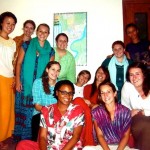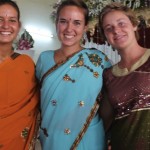When Lanterns Dot The Bangladeshi Sky

Close to nightfall one Wednesday night in Chittagong, Bangladesh, small lanterns sprinkled the sky, set into flight from the nearby Buddhist Temple. The paper lanterns encompassed the city spectators in an awe-inspiring and magical evening backdrop. I found myself inside a crowded bus of excited photography students, revelers in a different sort of awe–one produced by talk of camera angles, flash, and backlight.
I guess you could say it was another typical festival night here in Chittagong. A cultural gathering in a street and temple space, and a space that as a foreigner living only a short distance away, I felt compelled to join. Together with the Chittagong community, I celebrated Fanush, a lighting of the flying lanterns on the occasion of Aswini Purnima, the second most important Buddhist festival in Bangladesh after Wesak, or the Buddha’s birthday. This is a big festival across Southeast Asia, especially in Thailand, and they celebrated appropriately in Chittagong.
As a leader of the people lit another beautiful lantern, the packed crowd, which included young men, women, families, and children, screamed and together, we all watched as the lanterns began to dot the night sky.
This was my first night as a chaperone to a group of university students. Under the Bangladeshi night sky that seemed out of a Tim Burton film, the students led the way towards the crowds of men lighting kerosene and playing with fire. The energetic festival goers bounced up and down beneath the robust, pregnant paper lanterns. Each held part of the paper lantern, flashing smiles and screaming out with beautiful “Awwwhs” as the orange globes were set into flight. As a leader of the people lit another beautiful lantern, the packed crowd, which included young men, women, families, and children, screamed and together, we all watched as the lanterns began to dot the night sky.
Chittagong may be best known for its busy seaport, population of over 4.5 million, or for Dr. Mohammad Yunus and microcredit, but its multicultural heritage of Islamic, Hindu, and Buddhist traditions is equally impressive. “This is a beautiful ceremony and tradition,” said a friendly Bangaldeshi, as she stood in the center of the excited mass of moving bodies, surrounded by a dizzying 500 people and flames.
As a woman I do feel much safer here in Chittagong than I did attending a Durga Puja festival outside of Dhaka.
Another woman I met, moved her family to Chittagong from nearby Dhaka fifteen years ago after falling in love with the “melting pot of cultures” in Chittagong and its “small town feel.” This is small town? She hoped that it would be safer to raise her kids in Chittagong rather than Dhaka, saying she would have never taken her children to a “festival like this,” in the city of Dhaka. And that is a valid concern.
As a woman I do feel much safer here in Chittagong than I did attending a Durga Puja festival outside of Dhaka. But it has not always been this way.
Bangladesh in general can be somewhat intimidating to the female traveler. After wearing a baggy salwar kameez and having to consciously cover up of my arms and ankles can be frustrating at times. As an American woman, I am always easily spotted, despite my attempt to dress in local drab. While the festival was not a male-specific environment, as a woman I felt uneasy maneuvering in and out of the packed crowds, clutching my belongings and trying to keep and eye on the floating lanterns.
When Lanterns Dot the Bangladeshi Sky
An hour in, I managed to sneak away to a quiet gathering of Buddhists in a temple room to just sit. I took a long breath and began to process my surroundings. There I was, on the floor of the temple, listening to a monk pray into a solo microphone. I was able to watch those around me, the commotion of the outside festivities, and the beauty of a small Bangladeshi child sitting cross-legged, watching a monk with the same awe filled eyes I imagined my own looking like as I watched the glowing orange lanterns ascend into the night heavens.
Behind the child, images of the outside masses seeped through. The window had small geometric shapes cut into it. I took pleasure in watching the night light up within each of those shapes, while in front of me the small child continued to watch in admiration and awe.
I was able to watch those around me, the commotion of the outside festivities, and the beauty of a small Bangladeshi child sitting cross-legged, watching a monk with the same awe filled eyes I imagined my own looking like.
In celebration of the holiday, some of the site’s grounds became glittered with tiny, white candles and an eclectic array of bright lights, pictures of Buddha, and the occasional firework.
Before we left for the festival, a friend of mine taught me a few phrases in Bangla that would be helpful for warding off unwanted grabs or touches in the crowd. The phrases started off general enough, but the last phrase literally meant “get your hands off her (or me)!” While I did not use any of these phrases, I doubt that my voice would have even carried in such a crowded, large space. With the exception of a stolen pair of shoes, the night went smoothly, magically, and ultimately was so utterly enjoyable.
As an American, who against an ethereal backdrop, watched a monk clutch a microphone and speak words so mesmerizing that even the pixie-faced Bangladeshi child turned away from watching the majesty of floating lanterns to stop for a moment and listen.
Photo credit for When Lanterns Dot The Bangladeshi Sky by Pixabay.









Beautiful!